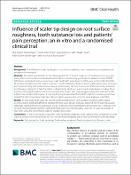Options
Influence of scaler tip design on root surface roughness, tooth substance loss and patients' pain perception: an in vitro and a randomised clinical trial
Journal
BMC Oral Health
Date Issued
2021
Author(s)
Nur Ayman Abdul Hayei
Noor Azlin Yahya
Syarida Hasnur Safii
Roslan Saub
Rathna Devi Vaithilingam
Nor Adinar Baharuddin
DOI
10.1186/s12903-021-01540-0
Abstract
Background: The influence of scaler tip design on root surface roughness, tooth substance loss and patients' pain perception is investigated.
Methods: This article was divided into the following parts: Part 1 Surface roughness and substance loss: an in vitro study, which involves intact extracted teeth sectioned and treated using a piezoelectric ultrasonic device (PM200 EMS Piezon, Switzerland) with a conventional scaler tip (FS-407) and a Perio Slim (PS) scaler tip (Perio Slim DS-016A).
All sectioned samples for tooth surface roughness (n=20) and tooth substance loss (n=46) analyses were measured and compared using a 3D surface texture analyser and scanning electron microscope (SEM) respectively, at baseline and following scaling. Part 2 Pain Perception: a clinical study, which was a split-mouth study design including 30 participants with gingivitis and/or mild chronic periodontitis; treated with supra-gingival scaling from teeth #13 to #23. Subjects were randomised to group A or group B. Group A was treated first with PS scaler tips, whereas group B was treated first with conventional scaler tips. Pain perception was recorded using the visual analogue scale (VAS).
Results: In vitro study: both scaler tips caused significant reduction in root substance roughness after scaling (p<0.05), but no significant difference between the two scaler tips (p>0.05) was observed. The PS scaler tip caused statistically significantly less root substance loss (p<0.05) when the initial thickness of the tooth was <1000 �m. Clinical study: the participants reported significantly lesser pain score during scaling using the PS scaler tip (median: 3) than when using the conventional scaler tip (median: 5) (p<0.05).
Conclusions: In the in vitro study, using a slim scaler tip design causes less tooth substance loss compared to a wider scaler tip design. In the clinical study, less pain was observed compared than a wide (conventional) scaler tip design.
Methods: This article was divided into the following parts: Part 1 Surface roughness and substance loss: an in vitro study, which involves intact extracted teeth sectioned and treated using a piezoelectric ultrasonic device (PM200 EMS Piezon, Switzerland) with a conventional scaler tip (FS-407) and a Perio Slim (PS) scaler tip (Perio Slim DS-016A).
All sectioned samples for tooth surface roughness (n=20) and tooth substance loss (n=46) analyses were measured and compared using a 3D surface texture analyser and scanning electron microscope (SEM) respectively, at baseline and following scaling. Part 2 Pain Perception: a clinical study, which was a split-mouth study design including 30 participants with gingivitis and/or mild chronic periodontitis; treated with supra-gingival scaling from teeth #13 to #23. Subjects were randomised to group A or group B. Group A was treated first with PS scaler tips, whereas group B was treated first with conventional scaler tips. Pain perception was recorded using the visual analogue scale (VAS).
Results: In vitro study: both scaler tips caused significant reduction in root substance roughness after scaling (p<0.05), but no significant difference between the two scaler tips (p>0.05) was observed. The PS scaler tip caused statistically significantly less root substance loss (p<0.05) when the initial thickness of the tooth was <1000 �m. Clinical study: the participants reported significantly lesser pain score during scaling using the PS scaler tip (median: 3) than when using the conventional scaler tip (median: 5) (p<0.05).
Conclusions: In the in vitro study, using a slim scaler tip design causes less tooth substance loss compared to a wider scaler tip design. In the clinical study, less pain was observed compared than a wide (conventional) scaler tip design.
File(s)
Loading...
Name
Influence of scaler tip design on root surface roughness, tooth substance loss and patients pain perception.pdf
Description
Influence of scaler tip design on root surface roughness, tooth substance loss and patients’ pain perception: an in vitro and a randomised clinical trial
Size
1.59 MB
Format
Adobe PDF
Checksum
(MD5):fb60a434e006768f46658923f955d127